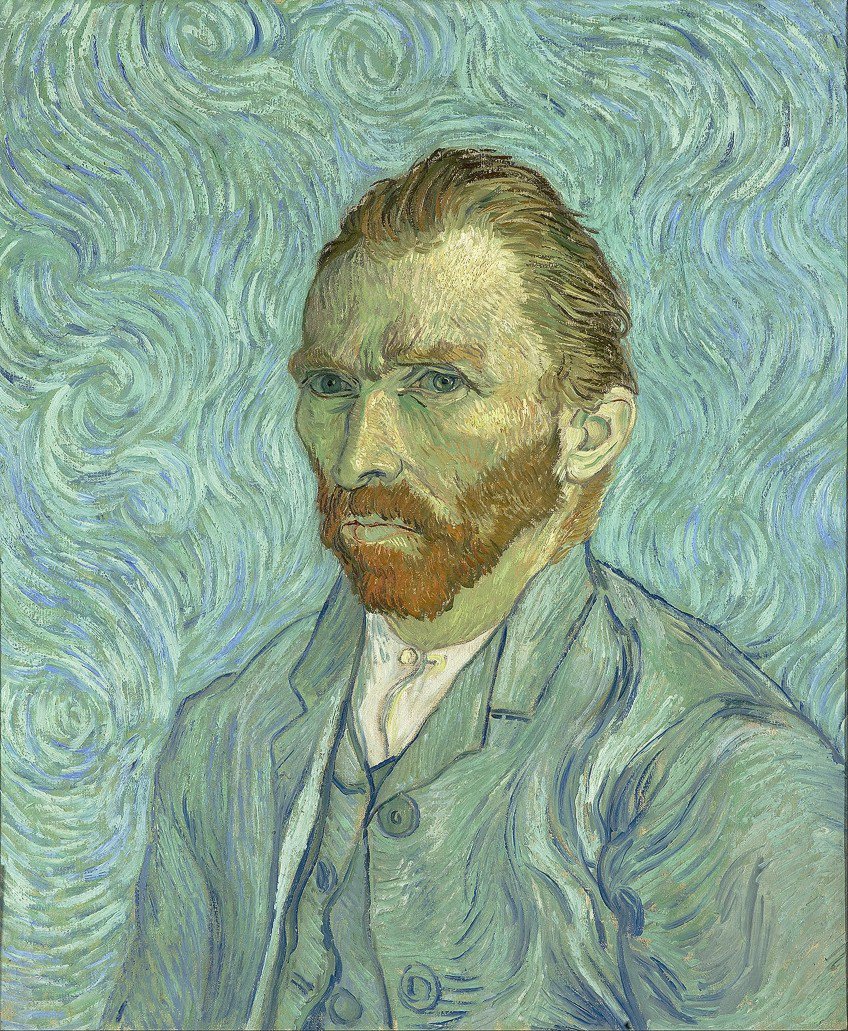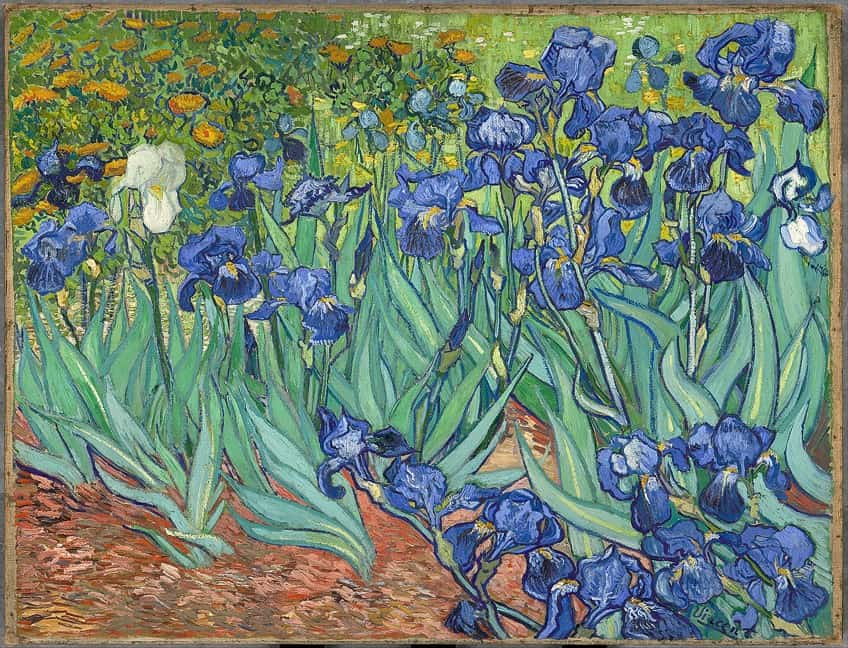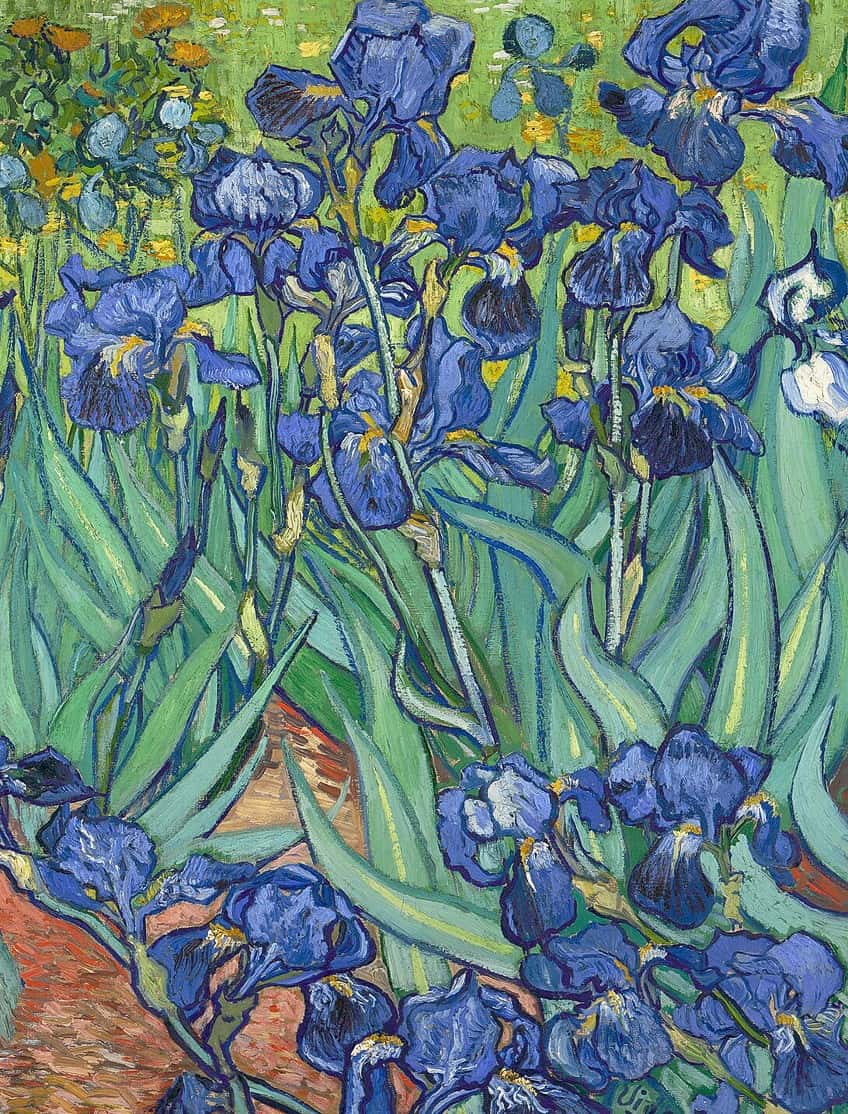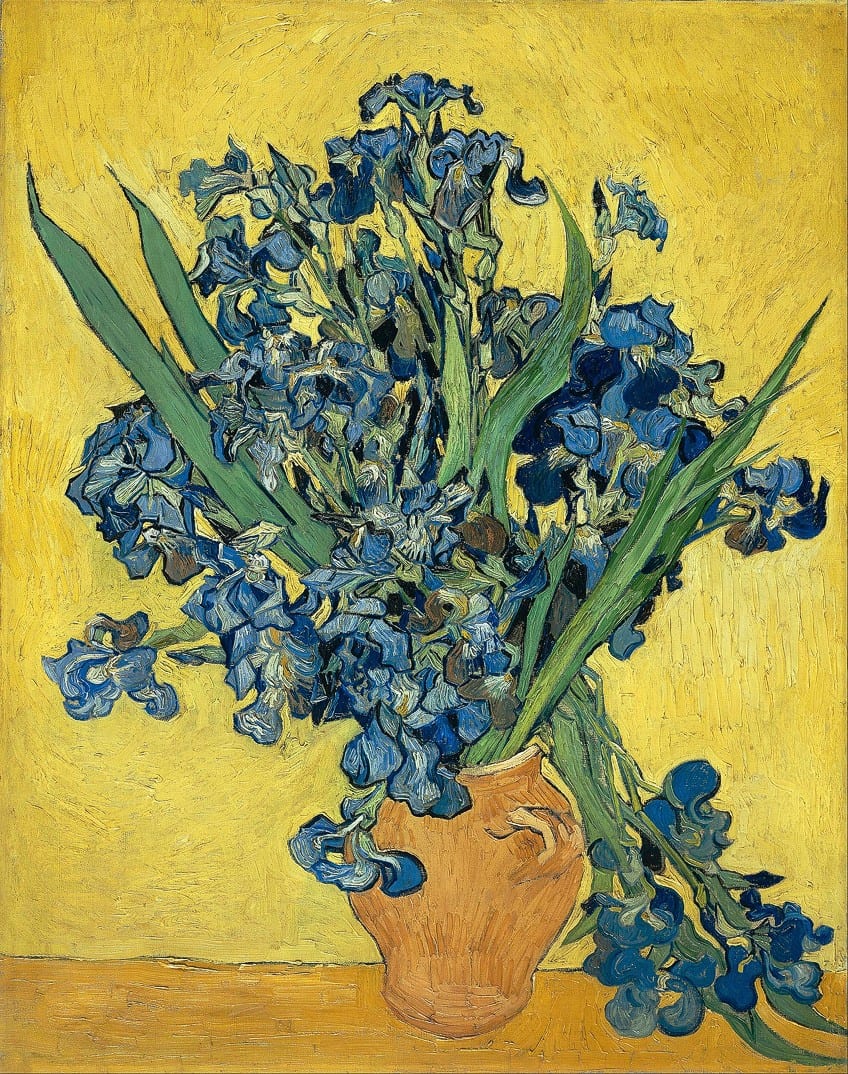“Irises” by Vincent van Gogh – Study the Famous Flowers
In the year before his death, the artist Vincent van Gogh produced several artworks while staying at the Saint Paul-de-Mausole asylum in St.-Rémy. One of these works was the Irises painting, which was produced in the asylum’s garden. The artist stated that producing this painting prevented him from going insane while there. To find out more about Irises by Vincent van Gogh, keep on reading further below!
Contents
Understanding Irises by Vincent van Gogh
| Artist Name | Vincent van Gogh (1853 – 1890) |
| Date Completed | 1889 |
| Medium | Oil on canvas |
| Dimensions (cm) | 71 x 93 |
| Location | J. Paul Getty Museum, Los Angeles, California, United States |
Within a month of entering the asylum, Van Gogh began to work on the Irises painting. Like many other artworks produced during this time, Japanese ukiyo-e woodblock prints were said to be a major influence behind this piece. It does not feature the intensity of his subsequent works, brimming with life and devoid of any feeling of tragedy. There are no known sketches of this work, which has led to the belief that it was itself a study. His brother felt that it was worthy of exhibition and entered it into the 1889 Société des Artistes Indépendants exhibition. Today, it is regarded as among his most renowned works. But, who was the artist behind the Irises painting?
An Introduction to Vincent van Gogh (1853 – 1890)
| Artist Full Name | Vincent Willem van Gogh |
| Nationality | Dutch |
| Date of Birth | 30 March 1853 |
| Date of Death | 29 July 1890 |
| Place of Birth | Zundert, Netherlands |
Van Gogh was born and raised in the Netherlands and his father served as a minister. It was possibly his father’s vocation that inspired Van Gogh to try and help people himself, alternately working as a missionary, preacher, and teacher. It was when he was working as a missionary for Belgian coal miners that he started to draw, and when he was fired in 1880 by the authorities of the church, he started to pursue art as a career. His first artworks featured earth-toned imagery of peasants and the natural world, yet he grew progressively more influenced by the French impressionists and Japanese prints.
Van Gogh traveled to Paris in 1886, marking the start of his artistic career.
Van Gogh lightened his earthy palette and contrasted complimentary colors to produce luminosity, influenced by artists such as Camille Pissarro. Several other painters such as Paul Gauguin and Henri de Toulouse-Lautrec encouraged him to utilize color emotionally and symbolically. The artist found Parisian life very stimulating, but also very draining of his energy and thus decided to move to Arles. He hoped that the pleasant climate of the region would calm him and that the beautiful colors and lighting of the south would inspire his painting. It was here that Van Gogh elevated his technique to a higher expression with his energetic brushstrokes and rich, complementary colors.

He hoped to establish an artist’s colony – a group of working painters – but despite many invitations to other post-impressionist artists, none arrived except Gauguin. The artist’s plan to try and attract other artists to the region failed, with only Paul Gauguin joining him for about two months. It soon became very apparent that their personalities were incompatible, with Van Gogh suffering a nervous breakdown shortly before Christmas of that year.
He then committed himself to the asylum in St.-Rémy in 1889, following days of non-stop production interrupted by continuous breakdowns. It was here that Van Gogh produced some of his most renowned works, such as the famous Irises painting.
An Analysis of Irises by Vincent van Gogh
As soon as Van Gogh arrived at the asylum, he set up his easel in the garden and produced around 130 artworks during his stay there. One of those was the Irises painting, which was painted directly onto the canvas without any prior planning or sketches. To him, it was merely a study, despite eventually becoming one of his most well-known paintings. While the irises may look blue today, this is only because the pigments have dulled with time, and they used to be a bold purple color. The inmates’ lives at the asylum were monotonous, with little to relieve their boredom. The arrival of an artist, particularly one from a foreign country, seems to have created a lot of excitement.
Van Gogh even wrote that all the inmates would come and watch him work in the garden, painting the various flowers that he observed there.
In fact, in the same letter, he stated that he had already begun two paintings on the first day that he was there, one of which was a violet Irises painting. Van Gogh had noticed some irises that had bloomed just after breakfast. He captured the fleeting beauty of their magnificent petals by bringing his easel, canvas, and paints into the patient’s garden. Irises were popular subjects among Japanese painters, whose works Van Gogh adored, and his choice of subject was undoubtedly inspired by this fact. In comparison to most paintings, the background appears somewhat crowded.

This distracts from the main irises in the foreground, yet it contributes to the feeling of the vastness of nature. The lovely organic forms used to create the flowers and the flowing curves that he used for the leaves provide a pleasing contrast. Van Gogh was adept at reducing complicated scenes to these fundamental aesthetic principles and that is why his artworks, such as his Irises paintings are so well-known. He was able to turn all of nature and life’s complexities and intricacy into stunning works of art.
The one thing you will notice about this artwork is that there are no shadows and it is not possible to determine from which direction the light source would be shining.
Symbolism
The original rich purple color made this painting dynamic and eye-catching, standing out against the background. Purple itself is an exciting combination of energizing red and tranquil blue. This seemingly contradictory combination must have seemed both pertinent and bewildering to the artist, who was trapped within an institution, seeking health and stability (blue) within a home for the mentally ill (red). The color purple has always held great symbolic meaning for many individuals.
Purple dyes were prohibitively expensive and uncommon in the 17th century, producing a connection with wealth and luxury that has endured to this day.

It is intriguing to speculate on how the artist would have felt about money at this point in his life, having never achieved financial success through his art. The iris flower also has significant symbolic importance as well. The goddess Iris served as a conduit between the earth and the realm of the gods in Ancient Greece. The Iris flower was named after her and was often placed over graves to invoke the goddess and facilitate the journey to the underworld.
Significantly, the artist’s own life would come to an end the following year after he took his own life with a revolver.
Color and Brushwork
It’s a brightly colored artwork, like you’d expect from the artist. Yet, it’s not bright or excessive, and the colors all work together in natural harmony. There is a nice balance of cool and warm colors. The oranges, reds, and yellows in the foreground and background are warm. Cool is represented by the irises’ vivid blues and light greens. Van Gogh used vivid highlights throughout the work of art to great effect.
Take note of the yellow dabs in the deep blue blooms, as well as the orange and yellow blossoms strewn throughout the backdrop.

Colorful accents such as these look good since they are both balanced and intriguing. Balanced in the sense that a little area of vivid color can deliver the same impact as a vast expanse of subtle color. They’re interesting because they make our eyes bounce around the artwork. Van Gogh’s brushwork appears to be both forceful and meticulous.
One can imagine that he produced with great concentration and a fully loaded paintbrush.
Versions
There are actually a few of Vincent van Gogh’s works that feature irises. Before he left the asylum, he painted a few still lifes, one of which was the Irises painting that is now displayed at the Metropolitan Museum of Art. He attempted to produce a soft and harmonious effect in this Museum’s painting by setting the violet blossoms against a pink background, which subsequently faded due to the minimal use of red pigments.

This artwork was owned by Vincent van Gogh’s mother until she passed away in 1907. There is another painting titled Irises at the Van Gogh Museum, and this one features the yellow background that the artist favored so much and used in several of his works.
Provenance
Julien Père Tanguy, an art dealer and paint grinder whose portrait the artist had produced on three different occasions, was the first owner of the Irises painting. Tanguy then sold the painting to Octave Mirbeau in 1892, an art critic who was also among the artist’s early admirers. He pretended they were a gift to avoid his wife’s displeasure over the expense. A photo from 1897 shows the Irises painting hanging in their dining room. It was purchased in 1925 by Jacques Doucet, a couturier from Paris who was an ardent supporter of modern art. Joan Payson, a wealthy heiress from New York, was the next owner, paying $80,000 for the Irises painting in 1947.
It was also the most expensive painting to be sold in 1987, breaking a record that remained for two and a half years.
The winning bidder was a notorious businessman from Australia, Alan Bond, who was imprisoned for fraud ten years later. He bid US$53.9 million for the painting at auction. Because he did not have enough money to pay for the painting after the auction, ownership of the painting was shared with Sotheby’s, who provided him with a large loan. He failed to repay the debt, and it was then privately sold to the J. Paul Getty Museum in 1990. It has never been disclosed how much the museum paid for the Irises painting, but it is estimated to have been close to what it was paid for at auction.
That concludes our examination of Irises by Vincent van Gogh. This famous painting was produced on the very first day that Van Gogh set up his easel in the patient’s gardens at the mental asylum that he booked himself into. We can see how the artist had decided to devote all of his attention to healing by focusing on his craft, painting more than 120 artworks while there. Yet, this particular one seems to stand out from the rest due to its calm and tranquil qualities, and beautiful representation of iris flowers. Despite the calm appearance of the work, Van Gogh continued to suffer from bouts of depression and took his own life only a year later.
Frequently Asked Questions
When Did Vincent van Gogh Produce the Irises Painting?
Irises by Vincent van Gogh was produced in 1889, a year before he took his own life. It was the very first painting that he produced after he admitted himself into a mental asylum. He set up an easel in the garden on the very first day, and proceeded to produce many paintings during his stay. Today, it is considered to be one of Van Gogh’s most valued pieces, even breaking sales records in 1987, when it sold for US$53.9 million. Today, it can be seen displayed at the J. Paul Getty Museum in Los Angeles, United States.
How Much Is the Irises Painting by Van Gogh Worth?
For a brief few years, this painting was regarded as the most expensive in the world! It sold at auction in 1987 for a whopping US$53.9 million! The person who bought it was a businessman from Australia called Alan Bond. However, he turned out to be a rather dubious character who was arrested for fraud only a year later. It was subsequently sold to the J. Paul Getty Museum for an undisclosed amount.
Jordan Anthony is a Cape Town-based film photographer, curator, and arts writer. She holds a Bachelor of Art in Fine Arts from the University of the Witwatersrand, Johannesburg, where she explored themes like healing, identity, dreams, and intuitive creation in her Contemporary art practice. Jordan has collaborated with various local art institutions, including the KZNSA Gallery in Durban, the Turbine Art Fair, and the Wits Art Museum. Her photography focuses on abstract color manipulations, portraiture, candid shots, and urban landscapes. She’s intrigued by philosophy, memory, and esotericism, drawing inspiration from Surrealism, Fluxus, and ancient civilizations, as well as childhood influences and found objects. Jordan is working for artfilemagazine since 2022 and writes blog posts about art history and photography.
Learn more about Jordan Anthony and about us.
Cite this Article
Jordan, Anthony, ““Irises” by Vincent van Gogh – Study the Famous Flowers.” artfilemagazine – Your Online Art Source. November 7, 2023. URL: https://artfilemagazine.com/irises-by-vincent-van-gogh/
Anthony, J. (2023, 7 November). “Irises” by Vincent van Gogh – Study the Famous Flowers. artfilemagazine – Your Online Art Source. https://artfilemagazine.com/irises-by-vincent-van-gogh/
Anthony, Jordan. ““Irises” by Vincent van Gogh – Study the Famous Flowers.” artfilemagazine – Your Online Art Source, November 7, 2023. https://artfilemagazine.com/irises-by-vincent-van-gogh/.



